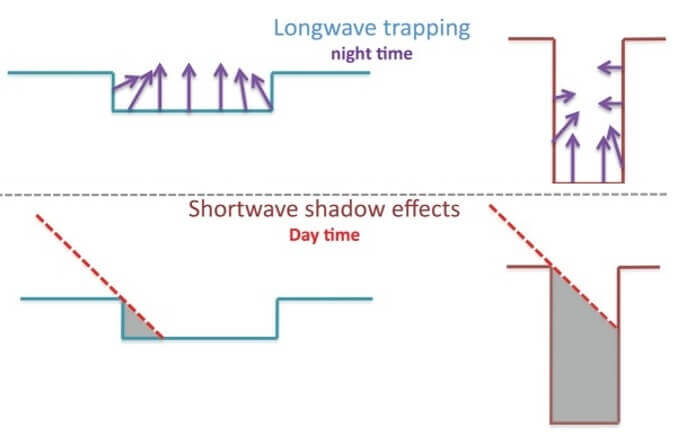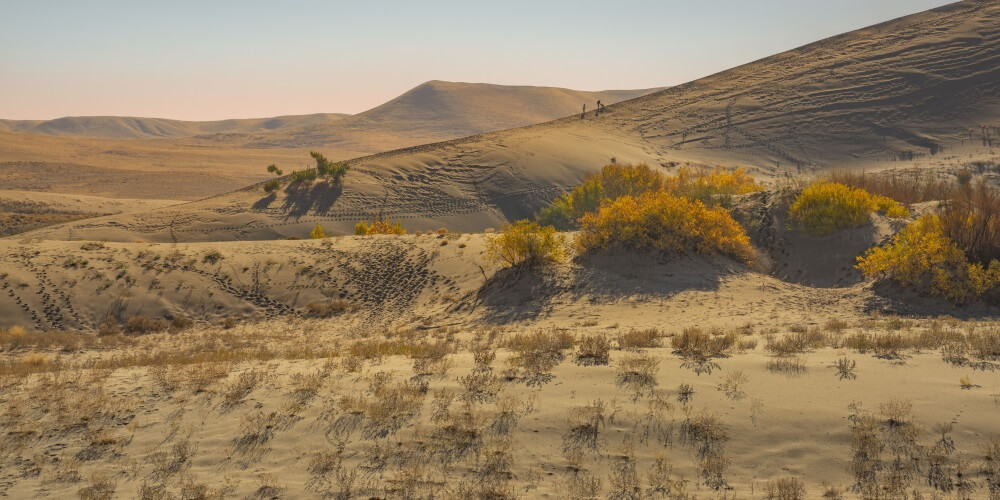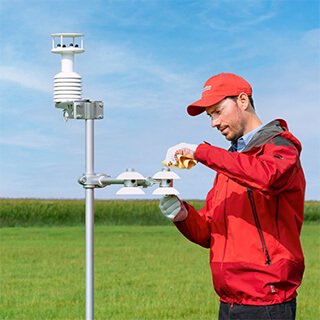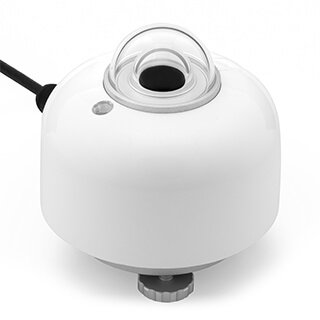Application of net radiometers in urban environmental studies

a net radiometer.
Net radiometers measure the earth’s incoming and outgoing short- and longwave radiation. This gives insight into the net radiation, which is the balance between incoming and outgoing radiation.
The energy budget helps predict climate change and understand crop growth, among other things. Therefore, accurately measuring this energy budget provides crucial insight in many environmental studies. In this article, we will specifically focus on urban environmental studies. Before that, we will explain net radiation further and how to measure it.
What is net radiation?
As the introduction mentions, net radiation is the balance between incoming and outgoing radiation of the earth’s surface. Radiation can be further decomposed into shortwave and longwave radiation. This leads to the following qualitative description of the net radiation:
Net radiation = (Incoming shortwave radiation + Incoming longwave radiation)
– (Outgoing shortwave radiation – Outgoing longwave radiation)
It would also be possible to define net radiation only by using total incoming and outgoing radiation. The difference between shortwave and longwave radiation stems from several factors.
First, the radiation that arrives on earth mainly consists of shortwave radiation, while the radiation that the earth emits primarily consists of longwave radiation. Furthermore, the two types of radiation impact our climate differently. The incoming shortwave radiation not reflected by clouds or absorbed by the atmosphere heats up the earth’s surface. This heat is then emitted as longwave radiation. This radiation is primarily absorbed in the atmosphere by greenhouse gases, heating the lower atmosphere. The heat is again emitted in terms of longwave radiation, some of which returns to the surface. If the concentration of greenhouse gases is too high, not enough longwave radiation can escape our atmosphere, leading to increased temperatures.
This information demonstrates why measuring net radiation and its components is crucial for environmental studies. The following section will focus on how we can measure it using a net radiometer.
How does a net radiometer measure net radiation?

two pyranometers (right) and two pyrgeometers (left).
A typical net radiometer, like our NR01, uses two pyranometers and two pyrgeometers for its measurements, one of each facing up- and downwards.
The up- and downward-facing SR01 pyranometers measure incoming and outgoing shortwave radiation, respectively. These pyranometers measure radiation using a glass dome and a black-coated thermopile sensor. The glass dome blocks longwave radiation, while the coating absorbs the transmitted radiation, changing the sensor temperature. This temperature difference generates a voltage. Calibration gives us the relation between the generated voltage and the temperature change, and this relation is used to calculate the incoming radiation.
The IR01 pyrgeometers measure up- and downward longwave radiation.They also use black-coated thermopile sensors, which are covered by a silicon window with a filter that blocks shortwave radiation; thus, the pyrgeometer only measures longwave radiation.
For more information on how net radiation is measured, read our article: How to measure net radiation: a practical guide.
Net radiometers in urban environments
Climate change leads to numerous changes in our surroundings, which can directly and indirectly impact humans and the ecosystem.
A direct effect can be felt in urban environments through the higher temperatures. Cities tend to be warmer than the rural areas surrounding them, an effect called “the Urban Heat Island” (UHI). This effect occurs, because buildings, roads, and other human-made structures absorb the sun’s shortwave radiation more than natural landscapes do. As explained before, absorbed shortwave radiation causes longwave radiation to be emitted, thus increasing the heat around buildings.
N.E. Theeuwes et al. studied the UHI effect in the Netherlands, specifically its seasonal dependence and relation to the urban canyon aspect ratio, which is the buildings' height divided by the street width between them.
Figure 3 shows how the urban canyon aspect ratio affects the UHI effect. A higher aspect ratio causes more shade coverage, decreasing the absorbed shortwave radiation. However, it also leads to better trapping of longwave radiation, thereby increasing temperatures. The reverse happens with a low aspect ratio.

longwave radiation during nighttime and the impact of shade on the absorption of
shortwave radiation during daytime.
In this study, the NR01 net radiometer was included in a mobile measuring station to measure short- and longwave radiation over a wider area than a single-point measurement could achieve.
This study showcased two counteracting processes between the nighttime UHI and the building aspect ratio: trapping of longwave radiation increases the UHI, whereas shadow effects decrease it. The net effect is decided by the amount of shortwave radiation entering the urban canyon. The result of this study can aid urban planning in using the aspect ratio to mitigate the UHI and create a more comfortable city.
Decreasing the Urban Heat Island (UHI)
Net radiometers are equally valuable for assessing solutions to problems like the UHI. The following two studies looked at ways to decrease the UHI, using NR01 net radiometers to verify their theories.
Samira Garshasbi et al. studied how quantum dots could help reduce longwave radiation emissions. Their solution is based on decreasing the shortwave radiation absorbed by surfaces. One way to do this is to increase a surface's reflectivity, which leads to lower absorption. Less absorbed light means less longwave radiation, causing a decrease in the UHI. Their study showcased that quantum dots can indeed mitigate the UHI by increasing heat rejection efficiency in cooling coatings.
Jiyun Song et al. studied a different solution based on a similar premise: reducing longwave radiation by changing the surface of buildings and/or streets. Their study used urban vegetation to alter surface energy levels, of which two types were investigated: mesic and xeric. Practical research was conducted in Phoenix, Arizona, located along the Sonoran Desert.
Mesic vegetation (such as grass) reduces temperature through evaporation. However, this means it requires a continuous water supply. On the other hand, xeric vegetation (such as trees) provides a cooling effect through shading and has a lower water demand.
Four different combinations of urban vegetation were used in this study: no vegetation, mesic vegetation, xeric vegetation, and both mesic and xeric vegetation. As expected, combining the two vegetation provided the lowest surface and heat canyon temperature, while no vegetation had the highest. Grass provided a lower ground, but higher heat canyon temperature than the tree, and vice versa. All combinations of vegetation reduced the thermal comfort level below 27 °C, which is a temperature at which health risks and heat fatigue can occur.

Conclusion
This article explained net radiation and how our net radiometer can measure it. Such net radiometers are part of many weather stations worldwide and are used for valuable environmental studies.
In this article, we focussed on three studies in which our NR01 was used to investigate the urban heat island and possible solutions. Our net radiometer has also been used outside urban environments for critical meteorological and climatological studies. For example, our NR01 is part of the world’s highest weather station on Mount Everest.
If you wish to know more about the capabilities of our NR01, be sure to contact us or read the other articles in our Library.










